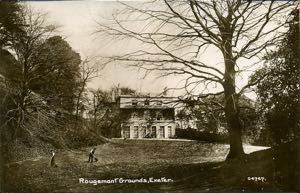
Rougemont House/Lodge
Page updated 3rd November 2014
Built in 1769 by John Patch, a surgeon at the Devon and Exeter Hospital, or possibly his father, Rougemont House is situated just outside the entrance to Rougemont Castle on part of the moat and defences of the castle. The house was a simple affair, with the front facing the Castle entrance. Some of the windows are still blanked off, indicating the house originated during the levying of the window tax which, surprisingly, was not repealed until 1851. The surrounding grounds were landscaped, in the 1790's, by Thomas Patch, John Patch's son.
Wine and wool
The wine merchant, and partner in the Exwick woollen mill of Banfill and Granger, Edmund Granger leased the house in 1787, and purchased it in 1793 from the Duchy of Cornwall. It was modernised in 1810, by adding the two ground floor, bow fronted bays, transforming into a Regency rather than Georgian house. The iron balcony was made by the firm of 'Iron' Sam Kingdon. He also built a Tuscan style entrance porch and then added stucco (rendered cement to you and me) to the walls.
Granger was advised by William Jackson, a local architect, painter and musician. A storm on 13th January 1828, blew down a tree in the garden, that was large enough to be mentioned in the Flying Post. Granger's widow, Mary, died in the house on 4th February 1846, at the age of 87, and the house was occupied by Richard Somers-Gard.
MP for Exeter
Grottos, rockeries and paths were added by Somers-Gard. He was also the guiding light for building the Royal Albert Memorial Museum. After his death, his widow opened the gardens in the 1870s to the public. After the death of Mrs Somer-Gard in 1889, the house came into the possession of Miss Phoebe Outhwaite, who in 1899, left £60,000 in her will to her sister Miss Outhwaite. In 1899, an incident occurred when a stranger gained entrance to the house claiming he was the legal owner. The butler sent the gardener to find a policemen, and two constables were called. The man, a Mr Northcote from Woolwich Arsenal, was a former resident of Exeter. He was meekly led away to the police station. The police surgeon was called and the man was committed to Digby Asylum. The report then revealed that his sister was also an inmate at Digby.
In April 1911, Miss Outhwaite died and the following December, the Rougemont Estate was put up for sale by Messrs Wilson and Gray for the owner. The property was withdrawn when the bidding reached £10,400 for the whole and £7,300 for the house and grounds.
The Council takes over
In 1912, the City Council stepped in and purchased the house and gardens. The council had to borrow £9,520 to purchase Rougemont House, Northernhay House and Castle Street Buildings. In 1864, they had sold the freehold of the house and garden and were pleased that they were buying it back, after 55 years for less than they received for it.
The Royal Albert Museum and the Fine Arts Committee appointed Mseers. Alford, Owen, Rowe, Townsend and Widgery, all city councillors, to report on adapting the house for use as a local museum and home for the Exeter Pictorial Society. On the 2 April 1912, the house was opened to the public for the first time.
Since then it has served as a school, and during the Second War, a billeting office. It became a temporary library after the main library was burnt out in the May 1942 blitz. Twelve rooms continued to be used until the completion of the new library in 1965.
The house was handed over to the Royal Albert Memorial Museum for their architecture and archeology department, with their conservation unit located in the basement from 1968. The Devon Folklore Register was also based at Rougemont House Museum during the 1980's. From 1978, it became the costume museum as part of RAMM–the exhibits were arranged as a series of rooms, each displaying costumes from a particular historic period, while two rooms were devoted to an extensive history and samples of Honiton lace. The Connections Discovery Centre was also run by the museum from the house. From September 2014 the house was no longer part of RAMM. It opened as the Exeter Mathematics School, a specialist sixth-form school catering for gifted young mathematicians.
An Adam style marble fireplace of circa 1820, from the old St John's Hospital School that was lost in the blitz, was removed from the ruins and installed in the drawing room of the house. A mosaic floor excavated from a house in Catherine Street, after the war, was relocated into Rougemont House, along with other Roman finds.
There was a second Rougemont House in Heavitree.
 Rougemont House
Rougemont House Mayor Vlieland opening Rougemont House to the public in 1912. Courtesy the Westcountry Studies Library.
Mayor Vlieland opening Rougemont House to the public in 1912. Courtesy the Westcountry Studies Library. An exhibit when the RAMM costume collection was at Rougemont House.
An exhibit when the RAMM costume collection was at Rougemont House. The gardens at Rougemont House.
The gardens at Rougemont House. The balcony at Rougemont House.
The balcony at Rougemont House.
│ Top of Page │